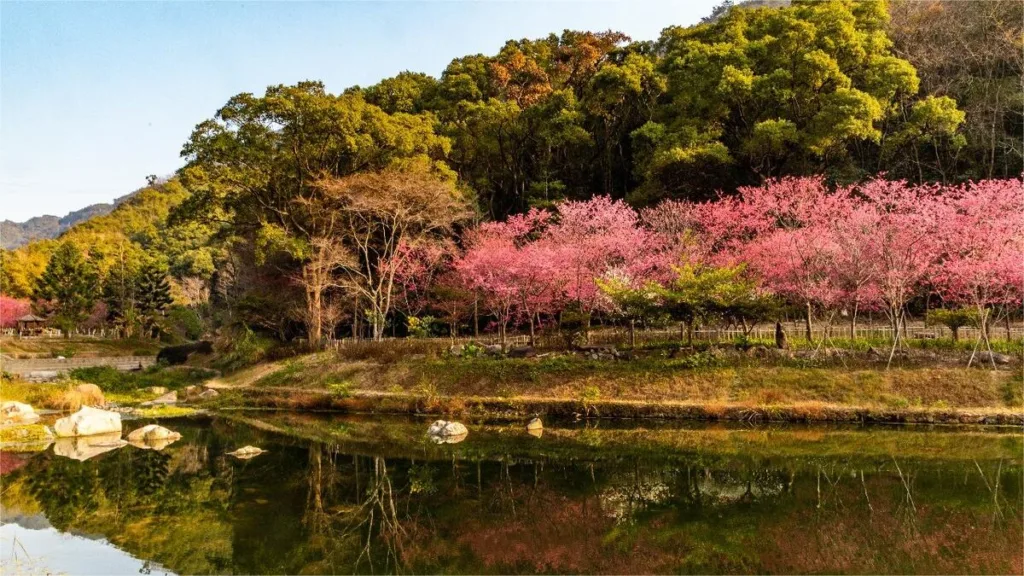Gushan Mountain (鼓山, Drum Mountain, Mount Gu), located on the north bank of the Minjiang River, is one of the most famous scenic areas in Fuzhou, China. It is named after a large rock at its summit that is flat and drum-shaped. According to legend, this rock produces a thunderous sound during storms, hence the name Gushan, which means “Drum Mountain.”
Gushan is a significant Buddhist site, with the Yongquan Temple situated halfway up the mountain. This temple is the most important attraction on Gushan and is home to the “Three Treasures” of the mountain: a thousand-year-old iron tree, a chicken-silk wooden offering table, and a set of blood-written scriptures. The natural landscape of Gushan is primarily formed by granite that has undergone extensive erosion, weathering, collapse, and accumulation over time, resulting in unique and varied rock formations. These include notable features such as Pantao Forest, Liu Hai Fishing for Toads, Jade Bamboo Peak, Eight Immortals Rock, and Drinking Water Rock. Additionally, there are numerous cliff inscriptions from various historical periods.
The winding Gushan Road, with its many curves, is a popular route for cyclists. The vibrant residents of Fuzhou have embraced cycling as a favorite form of leisure and exercise. Regardless of the season, Gushan is often enveloped in a mystical mist, and the sight of cyclists sweating their way up the mountain is common. They enjoy the pure air, fragrant soil, tranquil forests, refreshing springs, and the exhilarating feeling of reaching the summit and surveying the landscape below.
Table of Contents
- Basic Information
- Location and Transportation
- Highlights of Gushan Mountain
- Vlog about Gushan Mountain
- 8 Recommended Hiking Routes
- Other Attractions in Fuzhou Suburbs
Basic Information
| Estimated Length of Tour | 2 – 3 hours |
| Ticket Price | Free |
| Opening Hours | 24 hours a day throughout the year |
| Telephone Number | 0086-0591-88055770 0086-0591-83669008 |
Location and Transportation
Gushan Mountain is located in Gushan Town, Jin’an District, Fuzhou City, Fujian Province, approximately 8 kilometers from the city center. To get there, you can take bus 29, 36, 70, 107, 108, 201, 302, 303, or M3 and get off at Gushan Stop (鼓山公交总站).
Highlights of Gushan Mountain
Ancient Path and Pavilions
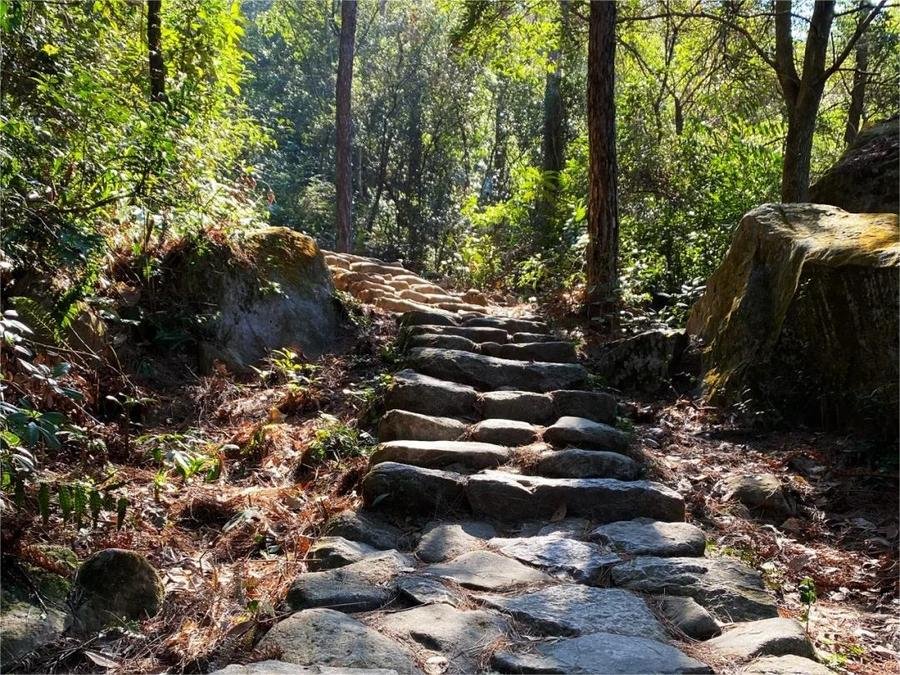
Among Gushan Mountain’s many attractions, the ancient path is particularly noteworthy. This historic trail features over 2,000 stone steps and seven pavilions, providing a scenic and culturally rich journey to the Yongquan Temple.
1. East Pavilion (“东际亭”) Starting from the “Minshan First Pavilion” at the foot of the mountain, the ascent begins at the “East Pavilion.” Crossing the Dong Ji Bridge and passing through the pavilion marks the start of the climb. After 99 stone steps, visitors reach the ruins of the “Yang Zhi Pavilion.” Along the way, numerous inscriptions on rocks add to the historical ambiance.
2. Stone Gate Pavilion (“石门亭”) The next pavilion, located 367 steps from the first, is the “Stone Gate Pavilion,” also known historically as the “Listening to Waves and Viewing Waterfalls Pavilion.” The constant sound of flowing water accompanies visitors here, creating a serene atmosphere.
3. Riding Clouds Pavilion (“乘云亭”) After climbing another 271 steps, visitors arrive at the “Riding Clouds Pavilion.” Along this path, various stone carvings such as “乘云 (Riding Clouds),” “仰涛 (Admiring Waves),” “小鼓 (Small Drum),” “天风吹梦 (Dream Blown by Heavenly Wind),” and “风怒涛飞 (Wind Roaring and Waves Flying)” provide visual and poetic delight.

4. Halfway Pavilion (“半山亭”) The “Halfway Pavilion” is reached after 494 steps from the previous pavilion, situated mid-slope, hence its name. Nearby, over a hundred more steps lead to the inscription “路通仙苑 (Path to the Immortal Garden),” and a side path reaches the “Eighteen Caves Scenery.” Close to this pavilion, another 300 steps feature the inscription “桃岩洞口 (Peach Rock Cave Entrance),” which leads eastward to the Peach Rock Cave and Peach Blossom Hermitage.
5. Tea Pavilion (“茶亭”) Approximately 520 steps from the “Halfway Pavilion” is the “Tea Pavilion,” named after the nearby tea garden. Stone carvings such as “欲罢不能 (Hard to Stop)” and “宜勉力 (Should Persevere)” are found along this route. According to legend, during the reign of the Qianlong Emperor, the governor of Fuzhou, Li Bo, inscribed “Hard to Stop” here, reflecting his struggle between continuing the climb and his unwillingness to turn back.
6. Pine Pass Pavilion (“S松关亭”) After another 300 steps from the “Tea Pavilion,” visitors reach the “Pine Pass Pavilion.” Nearby, stone carvings include a single-stroke “寿 (Longevity),” “龙 (Dragon),” “虎 (Tiger),” and words by Wen Tianxiang such as “忠 (Loyalty),” “孝 (Filial Piety),” “廉 (Integrity),” and “节 (Temperance).”
7. Changing Clothes Pavilion (“更衣亭”) A few dozen steps from the “Pine Pass Pavilion” lies the “Changing Clothes Pavilion.” It is said that the King of Min would change his clothes here before ascending further into the temple.
Yongquan Temple
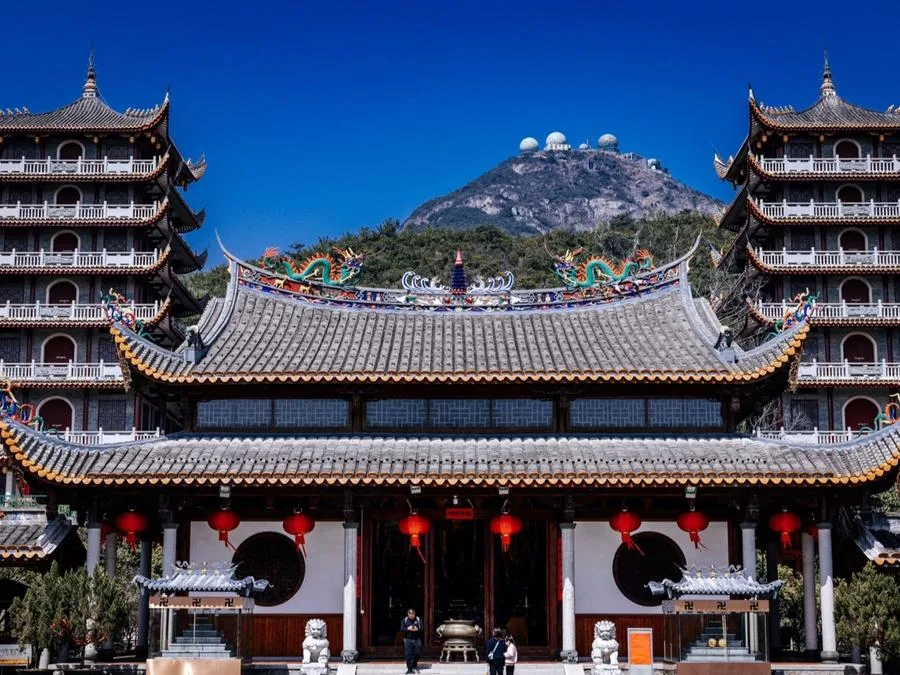
Yongquan Temple, covering approximately 1.7 hectares, maintains the architectural style of the Ming and Qing dynasties. Nestled against the mountains and valleys, the temple complex features 25 halls and pavilions, with the Grand Hall of the Great Hero (Daxiong Baodian) at its center. This hall is particularly striking with its towering pillars, flying eaves, and grandiose design. Inside, the statues of Shakyamuni Buddha, depicted in Han attire rather than traditional Buddhist robes, sit serenely. Flanking them are the Eighteen Arhats, each with a unique expression and posture.
Behind the main hall stands a 1.15-ton statue of the “Three Saints.” In front of this statue is a long table made of mulberry wood, which, despite enduring numerous fires, remains intact. This table is considered one of the temple’s treasures. The ceilings of both the Grand Hall and the Guanyin Hall are adorned with vibrant paintings. The Grand Hall’s ceiling features 129 dragon patterns and 86 red-crowned crane motifs, painted in 1882 during the Qing Dynasty. Additionally, there are 27 other designs, including kirin, white horses, elephants, and apes. The Guanyin Hall boasts 75 story paintings from the same period.
Yongquan Temple also houses several Ming edition silk-bound volumes of the “Great Avatamsaka Sutra” and statues and vases from the Ming and Qing dynasties. On either side of the Grand Hall, in the bell and drum towers, hang ancient bells and drums. Among them is the Diamond Sutra Bell, weighing about 2 tons and inscribed with 6,372 characters of the Diamond Sutra, dating back over 300 years.
Lize Peak

Lize Peak, also known as Absolute Summit Peak, is the highest point of Gushan Mountain, standing at an elevation of 870.3 meters. The peak is shaped like an inverted cauldron, and local proverbs suggest that if the peak is shrouded in clouds and mist, rain is imminent. Historically, Lize Peak was a favored spot for locals to watch the sea and the sunrise.
The peak is also a notable site for cliff inscriptions, which are among the most concentrated on Gushan Mountain. These inscriptions span various historical periods, including the Song, Yuan, Ming, Qing dynasties, and the Republic of China. Significant carvings include the “鼓山铭 (Gushan Inscription)” by Song Dynasty official Song Shenlie in 1072, “天风海涛 (Heavenly Wind and Sea Waves)” by Neo-Confucian master Zhu Xi in 1187, “请雨记 (Rain Prayer Record)” by Xu Luqing in 1232, and “青天白日 (Clear Sky and Bright Sun)” by Ming Dynasty governor Wang Wensheng.
Drinking Water Rock

Drinking Water Rock, is a prominent highlight of Gushan Mountain, located east of the main gate of Yongquan Temple. A stone archway inscribed with “灵源深处 (Deep Spiritual Source)” marks the entrance to this area. Descending about 60 stone steps along the cliff, visitors reach a gorge approximately 3 meters wide and 10 meters deep, resembling a stone cave, hence the name “灵源洞 (Spritual Source Cave).” Due to the famous “喝水岩” stone inscriptions, this area is collectively known as Drinking Water Rock.
On both sides of Lingyuan Cave, more than 200 cliff inscriptions from the Song Dynasty onward are concentrated, accounting for about half of Gushan Mountain’s existing 480 stone inscriptions. These inscriptions represent various calligraphy styles, including regular script, running script, cursive script, official script, and seal script, making this area a natural calligraphy treasure trove often referred to as the “Southeast Forest of Steles.” Among these, nearly 100 inscriptions date back to the Song Dynasty, 12 to the Yuan Dynasty, over 30 to the Ming Dynasty, and more than 100 from the Qing Dynasty to the present day. Notable inscriptions include “忘归石 (Forgetting Return Stone)” by the famous Song Dynasty calligrapher Cai Xiang, “喝水岩” by Shi Yuanchang, and inscriptions by Neo-Confucian philosopher Zhu Xi, national hero Li Gang, and modern literary figure Guo Moruo.
The name Drinking Water Rock is also associated with a beautiful legend. Over 900 years ago, Master Shenyin, the founder of Yongquan Temple, was reciting scriptures in this area. Annoyed by the noisy stream below the cave, he shouted to silence the water, causing it to change its course and flow out from the stone wall near the Guanyin Pavilion halfway up the eastern slope. The original streambed subsequently dried up.
Guling Scenic Area
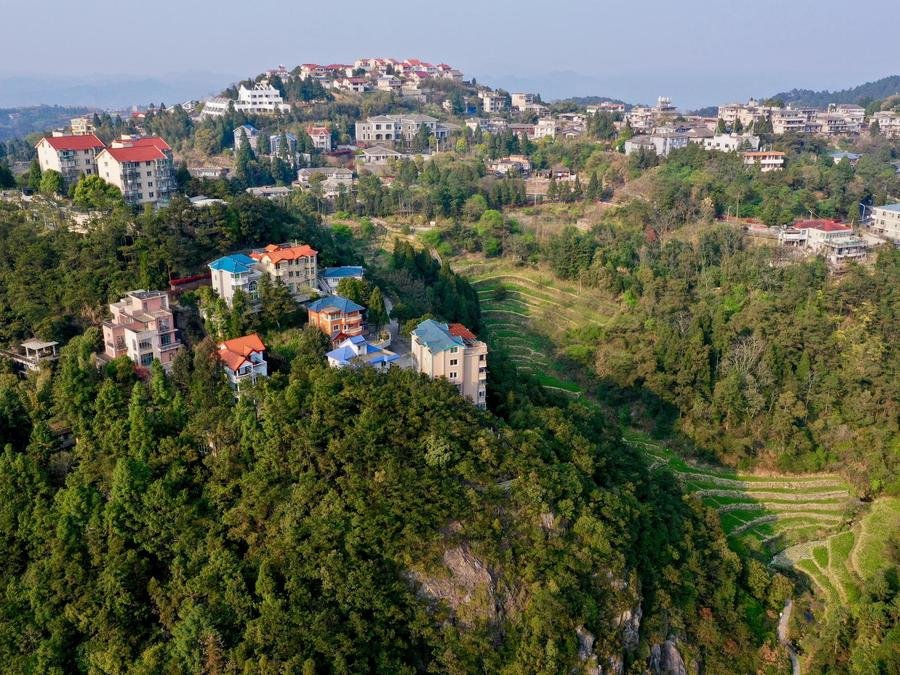
Guling, part of the Gushan National Scenic Area, serves as a refreshing summer retreat situated in the eastern outskirts of Fuzhou. Developed by Western missionaries in 1886, it lies approximately 13 kilometers from downtown Fuzhou, boasting elevations exceeding 800 meters. With summer temperatures rarely surpassing 30°C, Guling historically attracted many Westerners seeking respite from Fuzhou’s scorching heat. By 1935, it boasted over 200 distinctive summer villas, alongside amenities such as churches, hospitals, sports grounds, swimming pools, and international welfare societies. Guling was also notable among Christian communities in the Far East. Following the outbreak of the Pacific War, Watchman Nee acquired a group of missionary villas here, establishing “Houses of Deacons.” In 1948 and 1949, it hosted two significant national worker training sessions. Today, many villagers in the area are Christians, reflecting its enduring Christian legacy.
Moxi Scenic Area
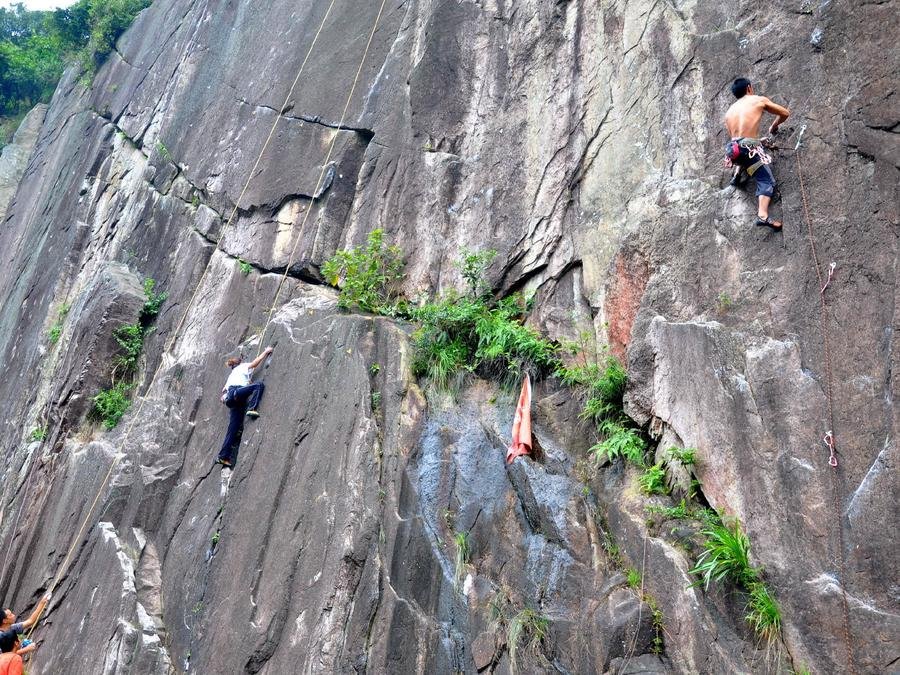
Located east of Gushan Mountain in Fuzhou, the Moxi Scenic Area spans the village of Kuai’an. Originally known as Longxi, this area stretches for 25 miles, originating from Gushan Mountain. Named “Moxi” due to its numerous water mills during the Qing Dynasty, it features winding streams that occasionally cascade directly downhill, creating a picturesque landscape. The path alongside the stream leads deeper into the mountains, where towering mountain forts and tea gardens on the eastern slopes evoke a serene retreat.
Today, Moxi has evolved into Fujian Province’s most mature outdoor natural rock climbing venue. It boasts three rock faces with 22 routes, including two traditional climbing routes and 20 sport climbing routes. These routes range in height from 10 to 21 meters, with difficulty levels from 5.7 to 5.12, all carved from granite. Additionally, there’s a 21-meter speed descent route with slopes ranging from 85 to 87 degrees, catering to thrill-seeking climbers.
Vlog about Gushan Mountain
8 Recommended Hiking Routes
Gushan Mountain offers several scenic hiking routes, each showcasing the natural beauty and cultural heritage of this prominent area in Fuzhou, China. Whether you’re a casual hiker or an avid trekker seeking adventure, these routes provide diverse experiences, from ancient temples and cliffside inscriptions to picturesque valleys and panoramic views.
1. Xieyuan to Banruo Temple Route Starting at Xieyuan, visitors embark on the eastern trail via the new hiking path. This route leads past landmarks such as Chuyun An and Haihui Pagoda before reaching Sheli Temple, where the Nine Dragons Gathering can be admired. Continuing east, hikers arrive at Banruo Temple, a reconstructed site of historical significance. Descending from the temple via a small path, the journey continues to Longmen Village, passing by Longmen Reservoir.
2. Xieyuan to Couple’s Valley Route From Xieyuan, hikers can take the western trail via the new hiking path. Halfway up, the route heads west towards Couple’s Valley, ascending along the creek valley past scenic spots like Yuantan and Tongxin Pool. Climbing further up the eastern path leads to an observation deck. The descent passes through Qianfo An (Thousand Buddha Temple) and Dharma Cave, showcasing the Eighteen Scenic Spots.
3. Xieyuan to Taoyuan Cave Route Beginning at Xieyuan, travelers follow the western trail via the new hiking path, passing through the Eighteen Scenic Spots of Dharma Cave and Thousand Buddha Temple. Along the journey, hikers will encounter road signs leading to Taoyuan Cave, home to a temple and monks. After exploring the cave, the descent follows a small path back to Xieyuan.
4. Xieyuan to Drinking Water Rock Route Starting at Xieyuan, adventurers take the western trail via the new hiking path, following the ancient route up the mountain. Highlights include stops at Halfway Pavilion, Tea Pavilion, and Changing Clothes Pavilion to appreciate cliffside inscriptions. Descending through Wansong Bay, passing Anle Bridge, and ascending via the Crystal Mountain Tea Garden leads to Drinking Water Rock, followed by a descent via stone steps past the “Stone Drum Famous Mountain Arch.”
5. Xieyuan to Lize Peak Route Beginning at Xieyuan, hikers follow the western trail via the new hiking path, passing through the Tea Pavilion and Changing Clothes Pavilion towards the “Stone Drum Famous Mountain Arch,” leading to the gate, millennium maple tree, and Songtao Pavilion. After passing through Lize Peak, the journey continues to Fengchi, descending via Laogu Mountain and Baiyun Cave.
6. Kuiqi to Sheli Temple Route Starting from Kuiqi Village near the primary school, hikers ascend Longevity Road to 1,080 meters. Continuing along a road past Yangshuzhuang Tomb leads to Sheli Temple. The descent follows through Guanyin Ridge, returning to Kuiqi Village.
7. Buxing to Baiyun Cave Route Beginning at Buxing Village near Gushan Middle School, hikers pass through Fansheng Temple and Longji Dao to Baiyun Cave (Liangxin Temple) to view the wind-moved stones (Turtle Stone). Heading west, the route continues to Immortal Footprints. The descent passes through the Eighteen Arhats Terrace (stone carvings of Arhats) and Jicui An, returning to Buxing Village.
8. Buxing to Gu Si Xilai Temple Route Commencing at Buxing Village, hikers pass through Fansheng Temple, Baiyun Cave, and Coffin Head Rock to Immortal Footprints, continuing west to the ruins of Gu Si Xilai Temple. The descent along the ancient stone steps leads to Zhanglin Village and Xiuling Natural Village.


